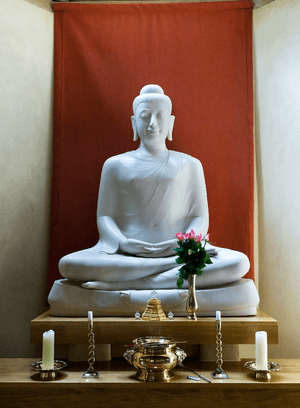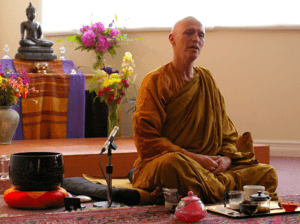Chithurst Buddhist Monastery facts for kids
Quick facts for kids Cittaviveka Buddhist Monastery |
|
|---|---|

The main building at Chithurst Buddhist monastery
|
|
| Religion | |
| Affiliation | Thai Forest Tradition |
| Location | |
| Location | Cittaviveka
Chithurst Buddhist Monastery Chithurst (W. Sussex), Petersfield, Hampshire GU31 5EU |
| Country | United Kingdom |
| Architecture | |
| Founder | Venerable Ajahn Sumedho Mahathera |
| Website | |
| cittaviveka.org | |
|
Basic terms |
|
|
People |
|
|
Schools |
|
|
Practices |
|
|
study Dharma |
|
Cittaviveka (which means 'discerning mind' in the ancient language of Pali) is a special place often called Chithurst Buddhist Monastery. It's a Theravada Buddhist monastery in England that follows the Thai Forest Tradition. You can find it in West Sussex, England, in a small village called Chithurst, located between Midhurst and Petersfield.
The monastery was started in 1979. Its main goal was to help train and support Buddhist monks (called bhikkhus) in the West. The current leader, or abbot, since 2019, is Ajahn Ahimsako.
A respected teacher named Ajahn Sumedho started Cittaviveka. He was guided by his own teacher, Ajahn Chah, from Thailand. Ajahn Chah even visited when the monastery first opened. It was the first branch of his monastery in Thailand to be set up outside of Thailand! Even though the monastery has changed a bit to fit Western ways, it still has strong connections with Thailand. Many people from different countries support it.
The name "Cittaviveka" comes from ancient Buddhist texts. Ajahn Sumedho chose this name because it sounded a bit like "Chithurst," the village where the monastery is. People also commonly use the name "Chithurst Buddhist Monastery." The monastery's land is quite large, about 175 acres (70 hectares), and it even goes into the next village.
After Ajahn Sumedho, other abbots have led the monastery. These include Ajahn Ānando (1984–1992), Ajahn Sucitto (1992-2014), Ajahn Karuniko (2014-2019), and Ajahn Ahimsako (2019–present). The monastery runs on donations from people. Visitors are welcome to stay for free as guests. They also offer regular teachings, usually on weekends.
Contents
A Look at the Monastery's History
How the Monastery Began (1979-1984)
Cittaviveka is known as a "Forest Monastery." This means it focuses on training monks to follow strict rules and live a simple, shared life. The monastery has a lot of woodland and open land called Hammer Wood. Here, you'll find small huts (called kutīs) where monks and nuns live.
The main activities, teachings, and guest rooms are in two nearby houses. Chithurst House is for men, and Āloka Cottage is for women. Hammer Wood was given to the Buddhist community in 1978-1979. This led to buying the old Chithurst House nearby. Later in 1979, another cottage was bought and named Āloka Cottage.
A small group of monks (called Bhikkhus) moved in on June 22, 1979. They were joined by novices (Sāmaṇera) and men living under special vows (anagārikas). Soon, four women also joined to train as nuns (mae-chee). In 1983, these women became the first sīladharā, which means "those who uphold virtue" in Pali.
The first big job for the community was fixing up Chithurst House, which took about five years. They also started replanting trees in Hammer Wood, a project that is still going on today.
An important event happened on June 3, 1981. A respected teacher from Sri Lanka, Ven. Ānandamaitreya, set up a special area for ordinations (called a sīma). This meant Ajahn Sumedho could now officially ordain new monks. On July 16, 1981, the first three monks were ordained there. While some ordinations had happened in Britain before, Chithurst was the first place to have a permanent sīma.
Ordinations happened yearly at Cittaviveka throughout the 1980s. This included the first ordination of sīladharā nuns in 1983. However, the sīma at Chithurst was just a square on the lawn. When other monasteries later built indoor sīmas, these weatherproof places became more popular for ordinations. Cittaviveka plans to build a new sīma inside its main meditation hall in the future.
On August 1, 1984, Ajahn Sumedho left Cittaviveka. He went to start a new monastery called Amaravati Buddhist Monastery in Hertfordshire. He felt there was a need for more space for the growing number of monks, nuns, and lay people who wanted to learn from him. He took half the monks and all the nuns to Amaravati. He left Ajahn Ānando, one of the original founders, to lead Cittaviveka as the abbot.
Important Developments (1992-Present)
Ajahn Sucitto, another original founder, became the abbot on June 7, 1992. Work continued to improve the monastery. More huts were built in Hammer Wood. Then, a large meditation hall (called the Dhamma Hall) was built between 1998 and 2004. It was built on the site of an old ruined building near Chithurst House.
Ajahn Sucitto stepped down in 2014. Ajahn Karuniko then became the abbot until 2019. In 2019, Ajahn Ahimsako was asked to be the next abbot of Chithurst Monastery, and he agreed.
In 2006, the English Sangha Trust bought another house for nuns. It's across from Āloka Cottage and is now called Rocana Vihāra. The nuns there live mostly independently from the male monks.
A few times a week, two or three members of the monastery community go to nearby towns. They go on alms-rounds (called pindapāda) to collect their daily meal, following a traditional practice. During warmer months, some also choose to go on long walking journeys (called tudong). This involves walking across the country for several weeks, living on collected food, and sleeping outdoors. It's a way to practice a very simple and disciplined life.
Other Monasteries in the UK
Cittaviveka is one of five monasteries in England that follow the same tradition. The others are:
- Amaravati Buddhist Monastery
- Aruna Ratanagiri (Harnham Buddhist Monastery)
- Hartridge Buddhist Monastery
- The Forest Hermitage (Santidhamma & Bhavanadhamma)




